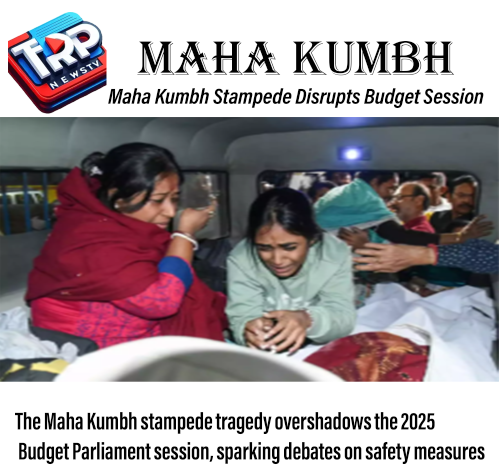
Maha Kumbh Stampede Disrupts Budget Session
The 2025 Budget Parliament session was brought to an unexpected halt as the tragic stampede at the Maha Kumbh Mela became a focal point of discussion, gripping lawmakers, officials, and citizens alike. The incident, which unfolded on the banks of the Ganges in Prayagraj, has not only shaken the nation but also led to an urgent outcry for better crowd management and more stringent safety protocols during mass gatherings.
While the Budget session typically serves as a forum for deliberating national finances, the devastating stampede tragedy forced the issue to the forefront of the national conversation. With hundreds of pilgrims dead and many more injured, the gravity of the situation overshadowed economic discussions and prompted parliamentarians from across the political spectrum to demand accountability, better planning, and government intervention in the future of large-scale religious events.
Maha Kumbh: The Tragedy That Stunned the Nation
The Maha Kumbh Mela, one of the largest and most revered religious gatherings in the world, typically draws millions of devotees. Held once every 12 years, it is a deeply significant event for Hindus, symbolizing spiritual purification. However, on the morning of February 1, 2025, chaos erupted during one of the most crowded bathing days, when the stampede broke out at one of the key ghats in Prayagraj.
Eyewitnesses described a horrific scene, with people rushing to enter the holy waters, leading to a deadly crush of bodies. According to reports, a combination of factors such as insufficient crowd control, poor infrastructure, and the sheer number of devotees present at once contributed to the tragedy. Videos and photos of the aftermath flooded social media, showing heart-wrenching scenes of victims being carried away by rescuers and bystanders alike, while families frantically searched for their loved ones in the chaos.
The Maha Kumbh Tragedy Interrupts Budget Session
As the news of the stampede reached Parliament, the atmosphere quickly shifted from one of anticipation for financial discussions to an urgent focus on the tragedy. Legislators, especially those from Uttar Pradesh and other affected regions, expressed their deep sorrow and shock at the loss of life. Prime Minister Narendra Modi and President Droupadi Murmu both issued heartfelt statements, extending condolences to the families of the victims and pledging government support for the survivors.
Opposition leaders, including Congress President Mallikarjun Kharge and AAP leader Arvind Kejriwal, demanded an immediate investigation into the incident and called for the suspension of the officials responsible for the lack of safety measures. Kharge criticized the government for its inability to implement sufficient crowd control systems at such a major religious event, which had previously faced criticism for similar safety concerns.
In response, Union Home Minister Amit Shah assured the parliament that the central government would work closely with the state administration in Uttar Pradesh to determine the causes of the stampede and ensure that those responsible were held accountable. He also announced that a special task force would be formed to oversee safety regulations at future events of this magnitude.
Maha Kumbh: The Demand for Accountability
The tragic events raised important questions about the role of both local and state authorities in ensuring safety at such a high-risk event. The Maha Kumbh, like many other large-scale religious or cultural gatherings in India, lacks sufficient infrastructure to manage the tens of millions of people who attend, often resulting in overcrowding and unsafe conditions. The government has been criticized for repeatedly underestimating the potential risks of mass gatherings, which has now led to this catastrophic incident.
Several parliamentarians took to the floor to propose measures that could prevent such disasters from happening in the future. Among the most vocal was Congress MP Shashi Tharoor, who urged the government to enact a national policy for crowd management at large religious and cultural festivals. He pointed to the use of technology, such as real-time tracking of crowds and better communication systems, as essential to maintaining order during such events. Tharoor’s suggestions were echoed by others, with calls for the inclusion of disaster management professionals in the planning process to ensure that safety measures were fully integrated.
BJP MPs, while expressing their grief over the tragedy, pushed back against what they described as attempts to politicize the incident. They argued that the tragedy should not be used as an opportunity for blame games but should instead serve as a reminder of the importance of proactive disaster management. Several also called for an urgent review of the infrastructure and technology used at religious events, with an emphasis on implementing internationally recognized safety standards.
The Role of Technology in Safety
One of the key takeaways from the debate was the increasing role of technology in large-scale event management. Experts and lawmakers alike stressed the need for modern solutions, such as AI-powered crowd management systems, drones for surveillance, and real-time data analytics to track crowd movement, ensuring quick responses in case of emergencies.
Public safety experts have pointed out that crowd management solutions are often underutilized at events like the Kumbh Mela, where millions of people gather in a small area. While previous Kumbh Melas have used surveillance cameras and other monitoring systems, there is a need to enhance these with cutting-edge technology that can predict potential bottlenecks and provide real-time alerts. Technology could also help authorities implement crowd control barriers or direct traffic to safer areas, potentially preventing incidents before they occur.
Additionally, it was emphasized that better communication between local authorities and emergency services could significantly reduce the response time in case of disasters. The lack of coordination between multiple stakeholders during the stampede may have exacerbated the tragedy, as people were unable to quickly reach emergency help when they needed it the most.
Looking Ahead: A Call for Change
As the debate surrounding the Kumbh Mela stampede tragedy continued to unfold, it became clear that a shift was needed in how India handles mass gatherings. Lawmakers from various parties agreed on the need for a more comprehensive approach to event planning, with safety as the top priority. The tragedy has sparked an urgent conversation about the potential dangers of large-scale religious and cultural events, especially when they are held in crowded spaces without the proper safety protocols in place.
The 2025 Budget session may have started with discussions about financial policies, but it is the Maha Kumbh stampede tragedy that will undoubtedly dominate the legislative agenda for the days to come. Moving forward, there will likely be calls for reforms to ensure that such an incident is never repeated, and the public’s trust in the government’s ability to protect its citizens during major events is restored.
Conclusion
The Maha Kumbh stampede has left the nation in mourning, and its tragic aftermath is now an issue that the Indian Parliament must address. While it has interrupted the usual flow of economic debates, it is a stark reminder of the challenges that come with organizing massive public events. As the investigation unfolds and Parliament continues its discussions, one thing is clear: India must rethink its approach to large-scale religious gatherings to ensure that safety remains at the forefront of such events.






